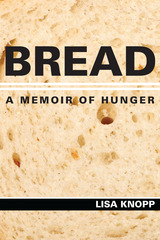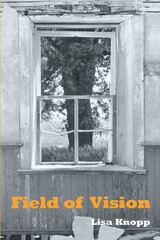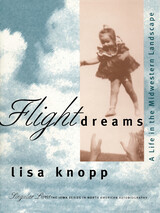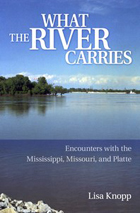
When Lisa Knopp was 54, she began tightly restricting what and how much she ate. A whisper, a shadow, or a flicker is what she wanted to become. When she finally realized that the severe restricting that had left her sick and small when she was 15 and 25 had returned when she was deep into middle age, she was full of urgent questions. Why did she respond to that which overwhelmed or threatened her by eating so little? How could she heal from a condition that is caused by a tangle of genetic, biological, familial, psychological, economic, spiritual, and cultural forces? Are eating disorders and disordered eating in older women caused by the same factors as those in younger females? Or are they caused, in part, by the sorrows and frustrations of aging in a culture that sees midlife and beyond as a time marked by increasing deterioration, powerlessness, dependency, and irrelevance?
Knopp’s focus on eating disorders among older women makes Bread unique among “anorexia memoirs.” Most experts agree that about 10 percent of those with eating disorders are older women, though the number is surely higher, since most women who restrict, binge, or purge don’t meet the narrow diagnostic criteria for anorexia nervosa, bulimia nervosa, or binge-eating disorder. And, too, many in this group disguise or misread their symptoms as being due to a health condition or changes associated with aging. For teenagers, symptoms usually manifest as a result of problems in their family of origin. But for older women, symptoms are more likely to manifest as a result of changes in the family they created, including divorce, infidelity, relationship conflicts, an empty nest, financial strains, a child with medical, emotional, or legal problems, and the demands of caring for a sick or aged parent, as well as their own health problems and fear of aging.
In her search for answers, Knopp read the research on eating disorders and imaginatively reentered those dark periods when she was self-starving. Bread, which is at once an illness, food, and spiritual memoir, will convince readers, both those who suffer from a conflicted relationship with food, weight, and self-image and those who do not, that eating disorders and disordered eating are about more than just food and weight. Indeed, they speak of our deepest hungers and desires and the various ways in which we can nourish and fill ourselves.

In this contemplative collection of essays, Lisa Knopp moves out from the prairies of Nebraska and Iowa to encompass a fully developed vision of light, memory, change, separateness, time, symbols, responsibility, and unity. Knopp charts a stimulating course among the individual, community, and culture that removes the boundaries between self and other, allowing one to become fully present in the world. Her keen vision sees beyond the ordinary to illuminate the mysteries and meanings of our personal and natural worlds.

“When I was eleven the world was filled with birds,”writes Lisa Knopp of her girlhood in Burlington, Iowa. Picking up where she left off in her first book, Field of Vision, Knopp knits together sections of her life story through a pattern of images drawn from nature. The most prevalent of these unifying themes are metaphors of flight—birds, wind, moving upward and outward and across the midwestern landscape from Nebraska and Iowa to southern Illinois.
Reminiscent of Thoreau's introspective nature writing and Dillard's taut, personal prose, each chapter in Flight Dreams stands alone as a distinct narrative, yet each is linked by profoundly personal descriptions of dreams, the natural world, defining experiences, and chance encounters with people that later prove to be fateful. Part Eastern meditation, part dream sequence, part historical reconstruction, Flight Dreams testifies to a deep understanding of how the natural world—its visible and invisible elements—guides our destinies.

Because Knopp was born and raised just a few blocks away, she considers the Mississippi from the perspective of a native resident, a “dweller in the land.” She revisits places she has long known: Nauvoo, Illinois, the site of two nineteenth-century utopias, one Mormon, one Icarian; Muscatine, Iowa, once the world’s largest manufacturer of pearl (mussel shell) buttons; and the mysterious prehistoric bird- and bear-shaped effigy mounds of northeastern Iowa. On a downriver trip between the Twin Cities and St. Louis, she meditates on what can be found in Mississippi river water—state lines, dissolved oxygen, smallmouth bass, corpses, family history, wrecked steamboats, mayfly nymphs, toxic perfluorinated chemicals, philosophies.
Knopp first encountered the Missouri as a tourist and became acquainted with it through literary and historical documents, as well as stories told by longtime residents. Her journey includes stops at Fort Bellefontaine, where Lewis and Clark first slept on their sojourn to the Pacific; Little Dixie, Missouri’s slaveholding, hemp-growing region, as revealed through the life of Jesse James’s mother; Fort Randall Dam and Lake Francis Case, the construction of which destroyed White Swan on the Yankton Sioux Reservation; and places that produced unique musical responses to the river, including Native American courting flutes, indie rock, Missouri River valley fiddling, Prohibition-era jazz jam sessions, and German folk music.
Knopp’s relationship with the Platte is marked by intentionality: she settled nearby and chose to develop deep and lasting connections over twenty years’ residence. On this adventure, she ponders the half-million sandhill cranes that pass through Nebraska each spring, the ancient varieties of Pawnee corn growing at the Great Platte River Road Archway Monument, a never-broken tract of tallgrass prairie, the sugar beet industry, and the changes in the river brought about by the demands of irrigation.
READERS
Browse our collection.
PUBLISHERS
See BiblioVault's publisher services.
STUDENT SERVICES
Files for college accessibility offices.
UChicago Accessibility Resources
home | accessibility | search | about | contact us
BiblioVault ® 2001 - 2024
The University of Chicago Press









